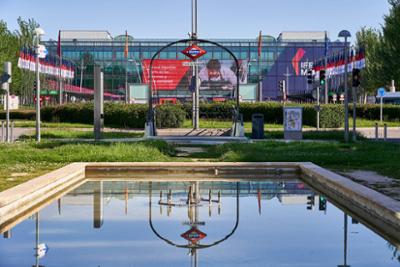
Tips for organising a sustainable event or trade show
Organising an event always has an impact, not only on the attendees, but also on the environment. Now… how can we make the event as sustainable as possible? The key is to take into account the negative impacts it may cause and try to minimise them while maximising its positive contributions. With Santiago Quiroga and Joana Gutiérrez from IFEMA MADRID, we review tips that will allow you to go one step further in your events. Remember that it is important to choose a venue with a good sustainability plan, but the sustainable commitment starts with the design of the event, also consolidating from the start a sustainable ecosystem with all suppliers and collaborators.
Choose a venue with a good sustainability plan
In terms of sustainability, you need to make sure that the venue has a clear commitment to sustainable development, for example through published and updated corporate social responsibility plans, volunteering schemes or similar. In addition, you can demonstrate this by ensuring it has one or more international certifications related to sustainability management, such as ISO 20121, ISO 14001, ISO 50001, EMAS, ISO 22320, ISO 45001, ISO 22000, ISO 27001... all verified by an independent third party.
These independent standards guarantee an efficient environmental, energy, emergency management (depending on the standard we are talking about) with a focus on continuous improvement, so as to ensure legal compliance and the implementation of the best available techniques, such as LEDs, renewable energies (such as solar panels or geothermal energy), supply of recyclable carpet, temperature control, water/paper saving measures, efficient waste management, etc.
Don't hesitate to enquire about all these points before deciding on one venue or another. In addition, you can ask the venue about their achievements in terms of sustainability (waste reduction, percentage of waste recycled, reduction of CO2 emissions, carbon footprint measurement of their facilities, donations they have made, volunteer hours, etc.). If they don't know how to answer any of these questions, be suspicious, they may not be as sustainable as they want to appear.
IFEMA MADRID has been ISO 9001, 14001, 20121, 22320 and 50001 certified since 2019, has an updated corporate social responsibility plan published and transmitted to all its stakeholders on the website, and a corporate volunteering plan published on its intranet. It has several achievements in sustainability, so do not hesitate to ask them.
A sustainable ecosystem with suppliers and partners
A sustainable event is an exemplary experience both for citizens and for other event organisers. If your event is sustainable, it has an added value. Good environmental practices incite reflection and encourage a change of habits. The results of a sustainable event or trade show: recycling, reducing (and compensating the emissions), zero paper... become visible, and the feeling of well-being transcends to the participants, which leads to greater awareness of how to take care of the environment.
It is not only up to you as the organiser, you should build a sustainable ecosystem by joining forces with suppliers and partners, whenever possible local suppliers and partners to foster the local economy. If you want to go further and establish even stronger partnerships (following the Sustainable Development Goals), you can let suppliers and partners know that you are open to carry out with them any sustainable initiative within the event. For example: have a team of workers at risk of exclusion in the catering team.
The commitment to sustainability starts from the design stage
In the design phase of the event (the pre-event), it is common to decide on the catering, audio-visuals or music… Why then, is it so difficult to also consider sustainability and why is it always left to the end? If you take sustainability into account from the design phase you will be guaranteeing that it is reflected in the rest of the event.
Equally, if you consider sustainability from the design phase you can find out where to put more effort depending on the type of event or trade show you are organising. For example: if you are organising an international show, you will have a lot of international visitors, so it will be key to act on sustainable mobility. Or if you have to buy carpet, think that, in order to be recyclable, it must have a specific composition, i.e., you have to buy a recyclable carpet.
Catering
On average, between 20% and 50% of the catering food is thrown away at events. If the venue has its own catering (or with your caterer) you should make sure that the kitchen is responsible. In buffets, the most common point of waste is looking for quality as opposed to a large quantity of different products. Also ask for confirmation just before the event to avoid no-shows, and ask about intolerances, allergies and religions. Surplus food can always be disposed of through food banks, foundations or apps like Too Good To Go.
Instead of disposable items such as straws or single-use containers, opt for glass tableware or biodegradable disposable products which, as well as being environmentally friendly, offer a rustic and modern look. Bamboo utensils and bowls are another good option. You can also use reusable table linen and napkins. Of course, prioritise seasonal food and keep in mind the proximity of all products (the famous km0).
Materials, paper, waste and sustainable mobility
For sustainable events, less is more. It is advisable that the raw materials used in stand construction, merchandising, packaging or graphic materials have sustainable certifications (such as FSC, PEFC or similar) and/or are made from recycled materials, although first it is advisable to reuse as many materials as possible from previous events. It is even possible to decorate the venue with decorations from previous events or made from recycled materials and if possible, setup by groups of people at risk of exclusion. Reducing the consumption of decorative elements means consuming fewer raw materials, at the same time saving energy in their manufacturing and in the treatment of the waste generated.
Buying carpet - one of the most widely used materials for trade fair production - that is recyclable reduces CO2 emissions and water consumption during its fabrication, and its subsequent recycling enabled IFEMA MADRID, last year, to avoid disposing of more than 50 tonnes of carpet waste in landfill, recycling it and transforming it for other uses, which in turn has enabled it to reduce more than 8 tonnes of CO2 emissions into the atmosphere. These targets are expected to be doubled in 2022 and 2023.
Regarding the use of paper, the most sustainable would be a zero paper event: promoting the event in digital formats instead of brochures, having digital registration and tickets... If there is no choice but to print, it is better to print on paper with sustainable certification (such as FSC, PEFC or similar) and/or recycled and/or chlorine-free, using vegetable inks instead of fluorescent, metallic or varnish inks. One idea for brochures is to consider their dual use, e.g., in the format and function of a bookmark, fan, postcard, calendar or ashtray.
By reducing and reusing the materials, we also save money and gain in efficiency and cleanliness (less waste). To achieve this, we need to think about the event tear-down phase, which is when most waste is generated. For this, it is very important to act from the design stage. Think about:
- Stands or parts of the stand with lighter materials, which can be easily dismantled and reused.
- Encourage digital advertising, minimising the use of tarpaulins/banners, or, if necessary, reusable.
- Print essential merchandising and graphic design material, or do not throw away the surplus and reuse it because its content or type of material allows it.
- Use rented furniture (shelves, tables, chairs, shelves, etc.) or decorative materials (natural or artificial plants, etc.), which are returned during the outgoing goods and reused again by the rental company.
- In addition, if you draw up a list of other materials that, once used, lose some of their usefulness (tarpaulins with the event's details, ropes, large plastic covers, objects, decorations, cables, badges, furniture), you can offer them after the event, to charities that can reuse them.
- Finally, depending on the type of event, during or at the end of the event you can organise a second-hand market with the materials that are no longer useful, thus giving a second life to these materials and recovering part of the economic investment.
Recycling the waste that we can no longer avoid generating during the set-up and tear-down phases is the next step. The organiser should require all its set-up workers to segregate the waste they generate and manage it in compliance with current waste legislation, and recycle it.
In addition, the venue must offer a segregated waste removal service (carpet, wood, paper-cardboard, plastic-packaging, etc.) and must ensure that if the waste generated by the fitters is correctly segregated, it will be recycled. The venue must penalise all players who do not segregate the waste they generate correctly.
Finally, during the event, we must set up clean points that include the 5 waste fractions (paper-cardboard, packaging-plastics, glass, organic and other waste). We must study the strategic places where to place these collection points in the form of bins (areas where food is dispensed, tables...) ensuring that they are highly visible and accessible to users and cleaning teams. The venue must provide a waste removal service from these clean points, so that, if they are well separated, they are managed separately and duly sent for recycling. In open areas where smoking is permitted, ashtrays should be provided for the disposal of cigarette butts.
IFEMA MADRID is very committed to reducing waste generation and increasing its recycling rate, which is why in the last four years it has reduced its waste generation ratio by more than 50% and increased its recycling rate by more than 60%. In addition, this year it has been awarded by UFI (The Global Association of the Exhibition Industry) for its project, in collaboration with 3 other partners (carpet manufacturer, waste manager and furniture manufacturer), of circular economy principles applied to its carpet management.
A massive event, such as a congress or an international fair, attracts a large number of people. The use and concentration of vehicles generates problems of air and noise pollution, traffic jams, etc. The reduced presence of cars and motorbikes improves the image of the event and increases road safety, reduces noise, the risk of accidents at the wheel and "bad fumes". To reduce the presence of vehicles, it is necessary to facilitate access to the venue by other means of transport: on foot, by bicycle, by bus, by train, by metro or by carpooling.
You should check and, if necessary, request the existence of metro/train/tram lines and bus stops close to the venue, as well as bicycle parking facilities. Inform attendees about the bus lines connected to the event venue and reward people who choose public transport or cycling (give them free drinks, discounts, T-shirts, etc.). You can even set up web applications for car sharing from different points of origin.
Finally, the measurement and reduction of CO2
Taking care of our CO2 generation at events is a most urgent task and probably the main focus of our sustainability efforts. Everything else has to be worked on, but if "the house is on fire" as Greta Thunberg says, it is emissions.
For the third consecutive year, the Ministry for Ecological Transition and Demographic Challenge has renewed IFEMA MADRID's presence in the carbon footprint registry, in what they call "scopes 1 and 2", thus demonstrating the truthfulness in the calculation of the carbon footprint and its reduction compared to previous years. In five years IFEMA MADRID has reduced its CO2 emissions ratio by 78%.
The carbon footprint calculated by the Ministry includes the impact of the events held at IFEMA MADRID, taking into account such aspects as gas emissions, fuel consumption (natural gas, diesel, petrol, butane), electricity consumption and potential diffuse emissions of refrigerant gas.








